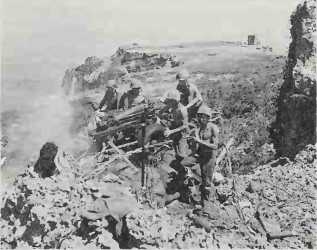Sed the Aisne and by the evening of May 29 they were beyond Sois-sons. German Seventh Army reached the Marne near Chateau Thierry, 56 miles (90km) from Paris, but, significantly, US 2nd and 3rd Divisions helped to block the advance at this point, with 2nd Division counterattacking at Bel-leau Wood on June 6. To expand the shoulders of the salient which had been formed, a fourth German offensive was improvised against French Third Army, between Noyon and Montdidier, on June 9. Once more the Germans were initially successful, progressing 6 miles (9km) on the first day, yet by June 11 this attack too had ground to a halt. Ludendorffs final offensive was unleashed east and west of Reims on July 15. Its failure, and the Allied counterstroke between the Aisne and Marne on July 18, persuaded Ludendorff to yield the strategic initiative to the Allies. PJS.
Marco Polo Bridge incident
(1937) see sino-japanese war.
Mareth Line, Battle of (March
19-28 1943). Montgomery’s
Eighth Army defeated Messe’s First Italo-German Army (Panzer-armee Afrika. renamed after Rommel relinquished command), which held the pre-war French fortifications of the Mareth Line on the Tunisian frontier.
In the first phase (March 19—22) Montgomery attempted to breach the Line’s coastal sector with a frontal assault by XXX Corps (Leese), while threatening to turn the position with a wide left hook through the desert by a specially-formed New Zealand Corps (Freyberg). Leese’s attack failed badly; Freyberg’s outflanking manoeuvre therefore became the main effort.
In the second phase (March 2228) Montgomery sent Horrocks with X Corps hq and 1st Armoured Division to reinforce Freyberg and break through the Tebaga Gap in the Matmata Hills to Messe’s coastal supply road. The Gap was breached on March 26-27 by divisions advancing behind a curtain of air attacks and artillery fire, a tactic devised by Desert Air Force (Broadhurst). Messe had to abandon the Mareth Line to avoid encirclement. WGFJ.
Margate, German destroyer raid
On (February 25-26 1917). In 1917, the British Dover Straits anti-submarine patrol was vulnerable to German destroyers based in Flanders. On this night, two forces of five destroyers each attacked. One fought an indecisive action with one British destroyer, the other bombarded Margate.

US field gun team in the Marianas, 1944
Marianas Islands campaign
(1944). The primary strategic importance of the Marianas lay in their potential as bases from which B-29 Superfortresses could strike at targets in the Philippines and the Japanese home islands. The main objectives were the large, strongly garrisoned southern islands of Saipan, Tinian and Guam. Adm Nimitz created two separate task forces for the assaults: the Northern, of 71.000 men. was to attack Saipan and Tinian; the Southern, with 56,000 troops, was
' to seize Guam. Landings on Saipan began on June 15 1944 and were characterized by fierce fighting and a fanatical determination shown by both Japanese troops and civilians not to surrender. On July 9 with over 20,000 of the defenders having fought to the death, the island came under US control. Tinian, three miles to the south, was the next objective and proved to be a simpler task. The assault was preceded by a massive bombardment by warships and Saipan-based aircraft. A feint landing on the south of the island confused the Japanese commander and the real attack in the north was largely unopposed, allowing the Marines quickly to secure a large bridgehead. Sufficient troops and artillery had been landed to repulse a Japanese counterattack the following day and, by August 1 when all substantial Japanese resistance was at end. American losses totalled some 300 killed while their opponents lost 5,000. This left only Guam, which was to have been invaded on June 13, but the difficulties encountered on Saipan forced a postponement. The delay was partially offset by the opportunity it offered to carry out a 13-day bombardment prior to the landings. However. sufficient Japanese defences remained intact to cause serious problems. US Marines suffered heavy casualties in establishing their bridgeheads but managed gradually to force their way into the island’s interior. By August 10 Japanese resistance had effectively been eradicated. The victory in the Marianas concluded amphibious operations in the Central Pacific. MS.
Maricourt. Village just behind the British front line, and at the junction of the British and French forces on the Somme, July 1 1916.
Mark I. The earliest pattern of British tank to see action in 1916. Armed with 2x6 pounderguns and 4 X 8mm machine guns (male) or 4 X 7.7 mm and 1x8 mm machine guns (female). Crew of 8. 105hp Daimler petrol engine. Max road speed 4mph (6kph), cross-country 2mph (3kph). Weight 27.5 tons. Radius of action 15 miles (24km). Superseded by Mks IV and V. Plans existed in 1918 for a Mk VIII “Liberty” tank to go into mass production in 1919.
“Market Time” Operation. Stemmed from the discovery in February 1965 of a camouflaged trawler offloading military supplies in Vung Ro Bay off South Vietnam. Beginning March 11 1965, US and South Vietnamese navy coastal patrols coordinated efforts to interdict seaborne infiltration of arms and supplies from North Vietnam into the South. “Market Time” forced the communists to accelerate development of the Ho Chi Minh Trail for infiltrating supplies. WST.




 World History
World History









